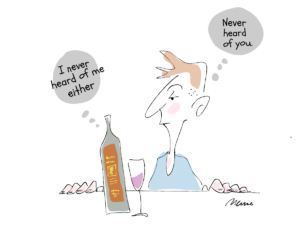
As a child, your correspondent loved television, cars and the newspaper. He grew up with three outlets for TV programming, a trio of automakers, and a daily Boston Globe. How very quaint and meager this all seems now.
No amount of nostalgia can induce me to want to return to the limited horizons of those days. The world as I grew to know it was simply too large, too varied, too full of surprises not to be embraced. Surely, reader, you feel the same. Or do you?
I ask because while it’s true that we have more choice in wine than ever before (a very good thing) trade reports reveal that for most consumers the bounds of their wine experience are still set by a tiny subset of grape varietals. Among these, Cabernet Sauvignon, Chardonnay, Pinot Noir, and Sauvignon Blanc will be the most familiar.
You might argue that this tenaciously held position has been adopted in self-defense, the wine world world being, as it is thought, so very confusing. Or you could lay responsibility for such chronic small-mindedness on the industry itself and its low opinion of consumer intelligence. No matter. The end of the Grapey Gang of Four may be, if not not quite at hand, at least unmistakably in the cards. What’s driving it is our warming planet.*
You know climate change is real when business interests begin to take it seriously, and not just as a talking point. This week, two news items pulled the curtain back a bit on decisions being taken inside national wine production governing bodies to confront the problem.
In the first, the French officially approved eight new grape varieties for use in their wine industry, namely Cualtacciu, Felen, Fleurtai, Rossula bianca, Uva biancona, Vintaghju, Xarello, and Brustianu. While it isn’t precisely clear what moved the authorities to opt for this particular slate of electees, all are known for qualities that make them well-adapted to conditions we expect climate change to force on us in the coming decades.
More alarming because more specific, are steps recently taken in Bordeaux where two years of research and consumer trials have resulted in what may be the first change in the roster of approved grape varieties since appellation rules were first established there. In this case, the authorities specifically cite climate change as the motivating factor.
“The vignerons were worried,” the president of the Bordeaux Wine Council says. “They felt that if nothing was done, in 40 years Bordeaux as we know it would not exist.” Merlot and Sauvignon Blanc appear to be the most endangered. Pillars of historic Bordelais winemaking, they may be off the board in a matter of decades.
There’s more work to be done, or course, but for now, growers are actively encouraged to establish test plots of red grapes Arinarnoa, Castets, Marselan and Touriga Nacional and whites Alvarinho and Liliorila. We can expect to find at least some popping up in our Bordeaux blends in three to five years.
One positive and very lucky thing about all this is that we still possess an enormous patrimony of varieties (it’s in the hundreds) available to us as we continue the search for wine vines that will keep pleasing, appetizing, engaging wine on our table for generations and centuries to come.
One bottle of nicely mature Brustiano here, waiter! And better make it snappy.